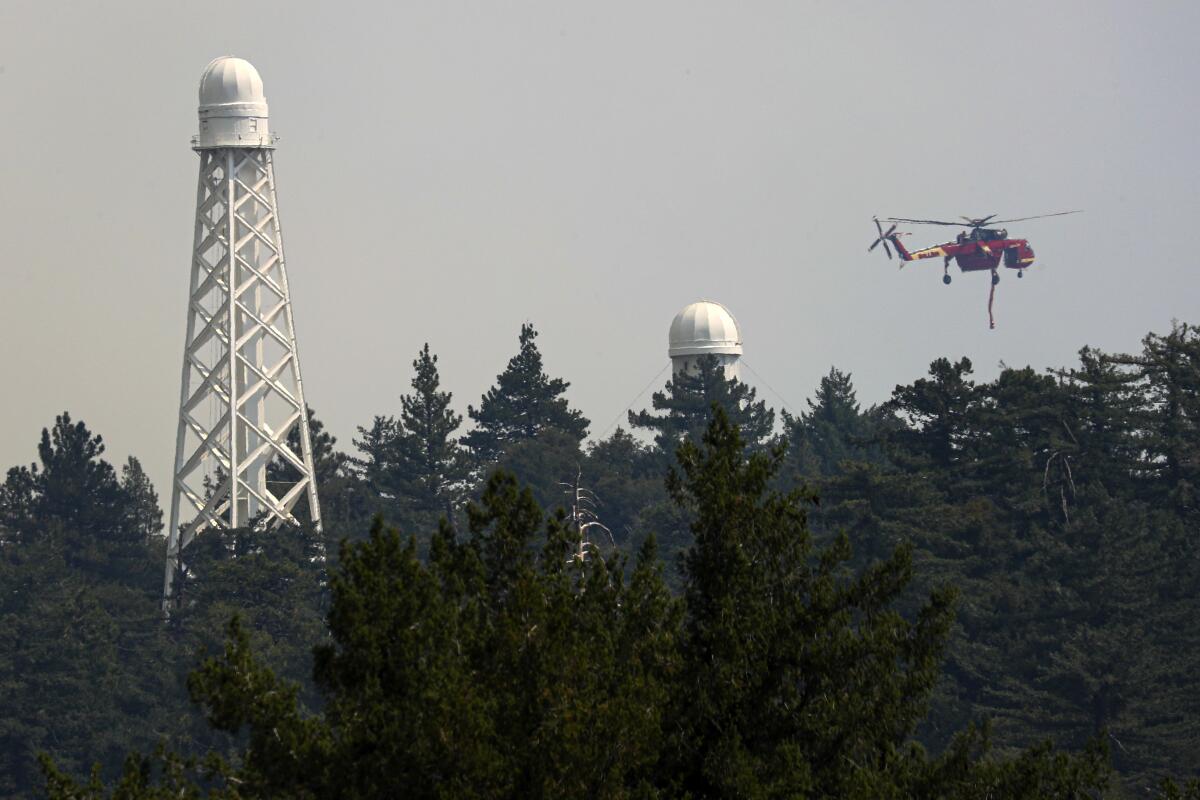Opinion: Mt. Wilson Observatory didn’t burn this time. It will one day

- Share via
For me, and I’m certain a lot of other people in Los Angeles, the pangs of dread caused by the smoke-fouled air and unforgiving heat wave after Labor Day weekend turned to despair at precisely one moment: when the Bobcat fire began marching up the slopes of Mt. Wilson.
Fire in the San Gabriel Mountains is nothing new. But as a lifelong Californian, I give myself permission to freak out when flames threaten the hiking oasis and observatory perched on the mile-high ridgeline over Pasadena. To say that I dread the destruction of the place where, quite literally, the nature of the universe was discovered is an understatement. Even the story of how the early telescopes were built — the first was hauled up on a narrow trail in pieces by humans and mules — would be enough to impress those who don’t know that it was at Mt. Wilson where astronomer Edwin Hubble made his observations in the 1920s that led to, among other things, our understanding of the universe as expanding.
A part of me would rather lose my own home in a fire than see anything on Mt. Wilson — the telescopes, the Cosmic Cafe, the grand crossroads of hikers, cyclists and trail runners — burn away. And yet anyone who regularly visits Mt. Wilson or explores other parts of the San Gabriels must share my feeling of inevitability that the day will come when the observatory cannot be saved by firefighters, as it was this month.
Perhaps emergency workers have succeeded in defending Mt. Wilson from the Bobcat fire because they’ve had so much practice, most recently with a small wildfire in 2017, and most memorably with the cataclysmic Station fire in 2009.
Just east of the observatory, the Echo Rock promontory offers a stunning vista of the canyons, peaks and massifs that make up the San Gabriels; the view also lays bare the firebreaks, recovering burn areas and other evidence of recurring disasters that imbue the human presence in even the most urban-adjacent of wilderness areas with its ephemeral quality.
You don’t have to venture far into the San Gabriels to understand how doggedly nature has resisted human colonization in this part of Southern California. Hostility to permanence in our mountains is nothing new, although climate change is certainly making things worse.
Yes, people have managed to engineer their way deep into the mountain range, but away from the handful of roadside stops there are ruins — of a hotel, a tavern, railroads, bridges, the final miles of a state highway, countless mines and, yes, another observatory. Some surrendered to fire, others to landslides or plain neglect — a reminder that it wasn’t for lack of trying that Los Angeles’ development was conspicuously halted at the San Gabriels. Today, some of these ruins, including a “Bridge to Nowhere” north of Azusa and an abandoned missile site atop the aptly named Mt. Disappointment, are some of the biggest draws for hikers.
For now, it appears the Mt. Wilson Observatory will continue to lure crowds because of its status as a functioning research facility and not as another ruin from recent history. This is, to put it mildly, profoundly relieving. It was visiting Mt. Wilson as a kid that clued me into the fact that there was much more to Los Angeles’ history than water theft and suburban expansion. It’s a place that connects visitors to both the region’s rich intellectual tradition and to the endlessly complicated and, yes, violent natural forces largely responsible for this area’s existence.
For the continued survival of Mt. Wilson as everything it has been for more than a century, we have firefighters and the observatory’s staff to thank. And, when that awful day arrives and the observatory can no longer be saved, we’ll also have them to thank for everything they’ve given us.
More to Read
A cure for the common opinion
Get thought-provoking perspectives with our weekly newsletter.
You may occasionally receive promotional content from the Los Angeles Times.











